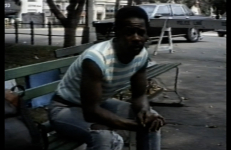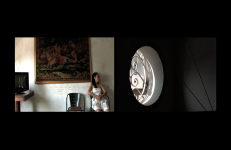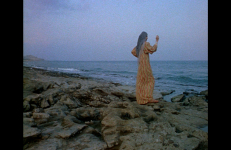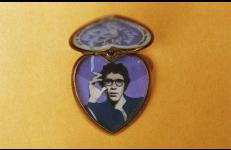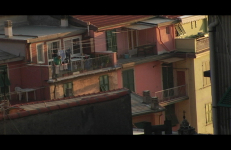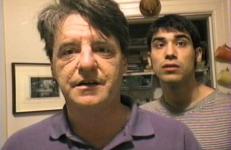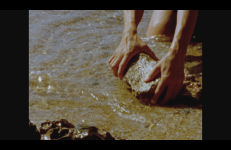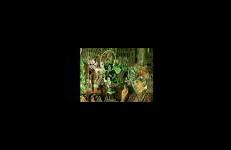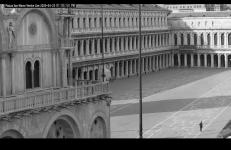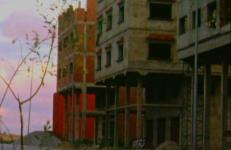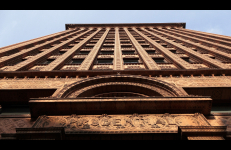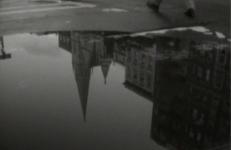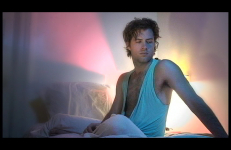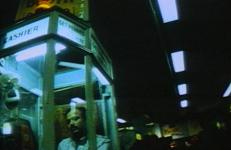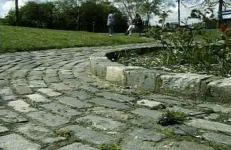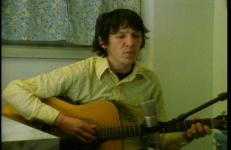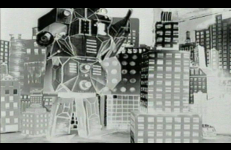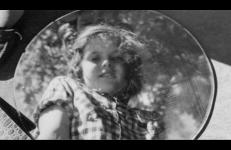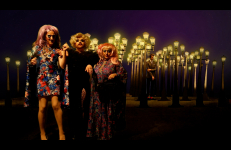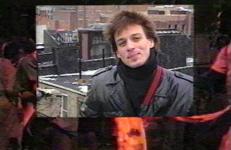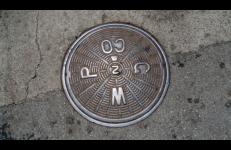In her video Homeward Bound, Bear documents the Homeward Bound Community Services, a group of self-supporting homeless citizens who gathered at City Hall Park in 1988 to protest New York City’s housing policies and Mayor Ed Koch’s lack of support for the homeless community.
City
Hotel Globo critically examines the changing urban surface of Luanda through video, photographic and performative incursions into the interior landscapes of the 1950s Hotel Globo in Luanda, Angola. The modernist hotel is still functioning in Luanda’s downtown, whose architectural heritage has been increasingly replaced with gentrified high-rise luxury buildings.
I Have Always Been A Dreamer is an essay film about globalization and urban ecology using the examples of two cities in contrasting states of development: Dubai, UAE and Detroit, U.S.A. Within the context of a boom and bust economy, the film questions the collective ideologies that shape the physical landscape and impact local communities.
Matt Wolf returns to Joe Brainard's iconic poem I Remember (1970) in this videowork. His archival montage combines audio recordings of Brainard reading from the poem, as well as an interview with his lifelong friend and collaborator, the poet Ron Padgett. The result is an inventive biography of Joe Brainard, and an elliptical dialog about friendship, nostalgia, and the strange wonders of memory.
In November of 2004, I was invited to spend a couple of weeks in Cinque Terre (a string of towns along the Northern Mediterranean Italian coast). The area has been listed as a World Heritage Site, by UNESCO, because of its exquisite coastline and the hill towns which cluster on its rocks. Indeed, one is easily overwhelmed by the place, the extraordinary beauty of the light and color, the geometry of the towns and the incredible way humans have inhabited the landscape.
I arranged a visit to poet/novelist Kevin Killian’s South of Market apartment in San Francisco to shoot a portrait of him, and when I arrived he had a guest, poet Cedar Sigo. They had corresponded earlier, but were meeting for the first time, and Cedar agreed to participate in our video shoot. This is perhaps the least planned, most verité and documentary of the videos about writers so far. Our immediate plan was for Kevin to read one of Cedar’s poems and for Cedar to read one by Kevin.
KG ruminates through performance and a portrait of Athens, on excerpts from poems in a book of poetry by Katerina Gogou entitled Three Clicks Left.
Performer: Kleoni Manousakis Music, Zeena Parkins
The performance artist Stephen Varble spent the last five years of his life working on an epic, unfinished performance-turned-video titled Journey to the Sun (1978-1983). Only partially complete and under constant revision, this complex work combined Varble’s history of making costumes for performances with his fantastic stories involving metamorphosis and martyrdom. In 1982, Varble decided to make a “prelude” to Journey to the Sun, combining existing footage with new video taken in Riverside Park in New York City.
Last Man is made of the raw footage of security cameras that stream online. During the spring 2020 lockdown imposed due to the Covid-19 pandemic, Dana Levy, who lives in New York, monitored the images transmitted live from security cameras in city centers and at airports, beaches, universities, restaurants, and zoos around the world. In them, these key venues, which in normal times are bustling with life, appear nearly devoid of human presence.
Laurie was inspired by Laurie Weeks’ uncanny ability to simultaneously embody her characters and write them from a clear distance. The text in question is just a few paragraphs from a draft of the novel Zipper Mouth, more than ten years in the making, and published by the Feminist Press.
A collaboration with writer Luc Sante made in Tangier, Morocco, a city where neither of us had ever been. En route from the airport to the city center, we found ourselves amazed by the landscape outside of the car windows; a massive construction project under way in all directions. While not in itself unusual, we were by struck dumb by the epic scale and seemingly incomprehensible plan of the development and were drawn to return together to this puzzling zone.
-- Jem Cohen
Buffalo, New York, which was once a prosperous city, is home to several architectural masterpieces built in the late 19th century to the early 20th century, such as the Darwin D. Martin House by Frank Lloyd Wright, the Guaranty Building by Louis Sullivan, and Kleinhans Music Hall by Eliel and Eero Saarinen. While some important buildings, including the Larkin Building by Wright, were demolished, the preservation movement has been active for the past several years. Architecture is embraced as a treasure, but it can be a burden to the city at the same time.
Long for the City is a short portrait of Patti Smith in the city where she lives. Patti recites the very first poem-song she ever wrote, and then a later one, "Prayer", from the early 1970s. We take a walk in her changing neighborhood, and I ask her what she saw. Footage was shot in the moment, as well as drawn from the archive I've gathered over many years. Long for the City can be considered a non-musical companion piece to the music short, Spirit, which we collaborated on in 2007.
Take a trip into and out of the body to ponder Time’s endless depths where Earth spirits roam and inner Demons lurk, and find secrets that hide behind the "self". Its here for you to see.
This title comprises Moon Lit Vows (2017), Boy in the Mirror (2015), Celestial Horizons (2019), Book of the Angel (2017) and Floating on the Currents of Consciousness (2019) which were compiled into this form by Mike Kuchar in 2022.
The result of over five years of Super-8 and 16mm filming on New York City streets, Lost Book Found melds documentary and narrative into a complex meditation on city life. The piece revolves around a mysterious notebook filled with obsessive listings of places, objects, and incidents. These listings serve as the key to a hidden city: a city of unconsidered geographies and layered artifacts—the relics of low-level capitalism and the debris of countless forgotten narratives. The project stems from the filmmaker's first job in New York—working as a pushcart vendor on Canal Street.
Lost Sound documents fragments of discarded audio tape found by the artists within a small area of East London, combining the sound retrieved from each piece of tape with images of the place where it was found. The work explores the potential of chance, creating portraits of particular places by building formal, narrative, and musical connections between images and sounds, linked by the random discoveries of the tape samples.
Lost Sound documents fragments of discarded audio tape found by the artists within a small area of East London, combining the sound retrieved from each piece of tape with images of the place where it was found. The work explores the potential of chance, creating portraits of particular places by building formal, narrative, and musical connections between images and sounds, linked by the random discoveries of the tape samples.
An independent film portrait of singer/songwriter Elliott Smith in Portland, Oregon in 1996, wherein he plays three songs. The songs were done live acoustic--in his old studio, a living room, and a bathroom (it was quiet in there). It's also a small portrait of Portland, Oregon.
The songs are "Between the Bars", "Angeles", and a cover of "Thirteen" by Big Star.
This is Elliott as I remember him, at his simple finest as musician.
¡Macho Shogun! was created by Reed Anderson and Daniel Davidson over a single weekend some time in 2000. It's your basic monster-robot / destroy-city kind of video that we wanted to make when we were kids but never did.
This title is only available on Suitable Video, Volume 1.
¡Macho Shogun! was created by Reed Anderson and Daniel Davidson over a single weekend some time in 2000. It's your basic monster-robot / destroy-city kind of video that we wanted to make when we were kids but never did.
This title is only available on Suitable Video, Volume 1.
This 12-minute video by Tom Palazzolo and Chicago writer Jack Helbig tells the story of the recently discovered Chicago street photographer Vivian Maier. Though she was unknown in her lifetime, her extensive body of work is rewriting the history of post-World War II American street photography. The video, told from the point of view of Maier herself, recounts her life and work, from her childhood in France to her move to NYC in 1951 and subsequent relocation to Chicago, where the majority of her work was done.
After an all-night session of editing Free Society, Garrin headed home with video-8 camera in-hand, only to happen upon the Tompkins Square riots. As police tried to enforce a curfew aimed at removing homeless people from the park, Garrin began gathering footage of cops beating up protesters. He was then attacked by police himself, as the camera continued to roll. The footage was subsequently incorporated into Free Society, in which the military myth of "protect and serve" is dismantled by first-hand experience.
Despite assurances from local municipalities, a fact of life is that Manholes blow sky high more frequently than most people realize. Manhole 452 directs the viewer’s attention to the shapes, sizes and patterns of manhole covers on Geary Street in San Francisco, and then plunges deep below into the manholes themselves to explore the hidden threat that lies below.
Despite assurances from local municipalities, a fact of life is that Manholes blow sky high more frequently than most people realize. Manhole 452 directs the viewer’s attention to the shapes, sizes and patterns of manhole covers on Geary Street in San Francisco, and then plunges deep below into the manholes themselves to explore the hidden threat that lies below.




